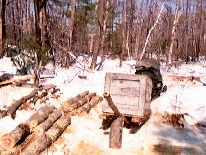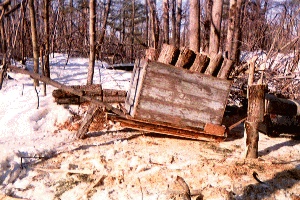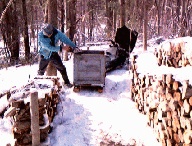

Once the wood is cut to stove length, the really big pieces may need to be split to be a size that is easy to pick up and handle. If you plan to split the wood before it is stacked then you may want to consider splitting it now. We like to set 5 or 10 stove size pieces on end, a few feet apart and split one after another. It's fun, but like stacked wood, you need to know what's under the snow to avoid problems with the maul. A 6 lb maul is easier to handle than a heavier one and works good on most logs. If a piece of wood is too hard to split we leave it.
When loading wood into the sled, we have two basic methods. With really small diameter wood, it's easiest to just throw it into the sled. Be careful not to beat the sled box up too much, throw from close range and aim the wood so it hits another piece of wood and not the walls of the box. With larger wood we find it much easier to handle if the wood is stacked in the box standing on end in 2 layers. The bottom layer is best for moderate sized wood. We load large (heavy) pieces in the top layer standing on end. This allows easy unloading when we stack the wood. Heavy pieces on top are easy to reach and the lighter pieces down the bottom are easier to pick up because they are standing on end and not laying on the bottom. Load the wood with the sled box on a ramp to minimize load on snowmobile engine [Next Section] Once the wood is loaded in the sled box, the snowmobile can move along the trail at a fast walking pace. Don't stop on the trail or you will have to reset the ramp on the sled to restart up of the sled.
When a snowmobile first begins to move forward, the belt on the engine slips on the pulley as it engages. This system acts like the clutch on a car. To extend the life of the snowmobile engine and the belt you want to minimize the load that the snowmobile must pull when the belt first engages. Once the belt is fully engaged on the pulley, then the snowmobile is designed to handle a heavy load and it can adjust without slipping to whatever load conditions it encounters. (This is a very interesting and simple design ... check out snowmobile repair books for details).
A critical part of the snowmobile sled system is to make sure your snowmobile is under the least load when the belt first engages to move the machine forward. The snowmobile is designed to handle start up with a person on the snowmobile. The question is how to minimize the impact of pulling a sled holding approximately 500 lbs. of cut green wood when the snowmobile first begins pulling.
There are 2 mains sources of resistance from the sled to start up.
1) The runners may freeze to the snow. In the old days, Eskimos always turned their dog sled on the side when they stopped to avoid a freeze up. When a sled (or ice skate) moves along the snow it forms a thin layer of water on the snow as it slides. This thin layer of water greatly reduces the friction and is what makes a sled so efficient. When the sled stops this water can freeze the sled runners to the snow.
2) The weight of the sled has a natural resistance to movement (inertia). A weight of 500 lbs (1/4 ton) can be a sizable resistance.

SIMPLE SOLUTION: Prop up the rear of the Sled to create a small ramp. By propping up the back of the sled with a pole and a piece of firewood (either before or after loading), only a very small part of the front of the runners are touching the snow. This greatly reduces the surface of the runners that can freeze to the snow. Propping up the sled from the back also creates a ramp that the sled will slide down as soon as the snowmobile moves forward. Since the pole is at an angle of about 30 to 45 degrees, the sled will gain speed rapidly as it slides forward down the pole. This slide pushes the sled forward just as the snowmobile begins to move and gives the sled a good start.
We find it easier to prop up the sled when it is empty, but that means we have to be careful when loading wood not to knock the sled off the pole ramp. If the sled falls off the pole while loading it can move a considerable distance to one side or the other as it falls and presents a danger to anything it lands on. For this reason, it may be wise to consider using a long pole levered under the sled to lift the sled after it is loaded if it can be done without strain, to avoid the danger of the sled falling while being loaded.

By the time the sled is off the pole the pulley of the snowmobile is fully engaged and able to adjust to load conditions as needed without strain on the belt or engine. Low friction travel on the trails is now possible and even relatively steep trails can be climbed if speed is maintained. The best speed for good control and traction is about a fast as a rapid walk.

Near your house is a good place to stack your wood to dry and later move into your house as needed. The snowmobile has a clear passage between the rows of wood. Wood is stacked on either side of the snowmobile. Between each trail for the snowmobile are 2 rows of wood with a narrow walk space (2 feet - enough to walk down row to adjust wood as needed) between them. Poles (3-5" diameter - larger resist rotting longer) are laid out on the ground before the snow falls. 2 poles under each row, 2 rows are set 2 feet apart then a 4 foot drive space (snowmobile clearance and work space to unload) and another 2 rows set 2 feet apart (see photo).

The careful spacing of rows allows easy access with the snowmobile. As wood is used up, the snowmobile can reload any empty spaces by driving right up to the empty spaces. Rows are parallel and can be as long as the terrain permits. All trails converge after leaving the rows and follow a loop back to the forest. This arrangement is very similar to a railroad yard, and allows for easy access to all parts of the wood storage area without blocking any access to stored wood.

Unloading wood is easy. Wood stacked on end in the sled box when you where in the forest is now easy to pick up and stack in rows. Straddle the row when stacking a new row. Unload wood to cover the poles and build the stack as high as the row will be (high rows take up less space, low rows are less likely to fall and are safer if you have children in the area). Once the row is filled to full height them move down the row and repeat the fill. This method is easy on the back and requires the least reaching and stretching. Small diameter wood throw into the box in forest may require moving to a new position in between the sled and the row to reach the wood on the bottom of the sled box.
We always stack split wood with the bark side up to protect again rain and snow and allow for longer storage. Uncovered wood in sunny locations stores well. A covering over the top of the pile makes it easier to get wood without snow in the winter, but many people don't think it's worth the extra work. Never cover the wood fully because it needs air circulation to dry. Plan to cut wood in the winter for next winter as wood needs a summer in at least partial sun and good air circulation to dry.

Using the drive thru method of stacking you can build as large an inventory of
wood as the space allows. Many people like to build up a reserve of wood. A 3
to 5 year supply is good insurance. Having a surplus of wood allows you to
take a winter off from cutting wood if you want a vacation, have health
problems, or have other work. For longer storage, make sure the area is dry
and sunny to keep the wood from rotting.

THE GOAL: Design a system of moving firewood out of the forest that is practical for the average person, requires the least investment in wood moving equipment, and does the least damage to the forest.

PROPOSED SYSTEM: Using a chain saw, an older snowmobile and a home made sled, this system allows an average person to move approximately 500 lbs. per sled load of green cut firewood along snowmobile trails. Snowmobile trails are less work to make and maintain than roads and avoid the problems associated with road maintenance (mud, ruts, culverts, soil erosion, etc.). Older snowmobiles (1970's - 80's) cost less (starting around $500+) than older pickup trucks or tractors (at $2,000+). By moving wood in the winter you can take advantage of the snow to make good trails even over rough terrain. The less friction provided by the snow allows a low horse power engine (about 20 hp) to carry a good size load (approximately 1/3 face cord = 500 lbs = 1/4 ton) on very narrow, low maintenance trails.